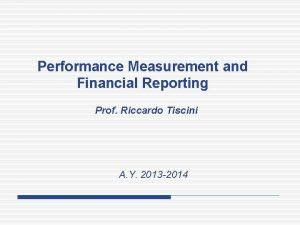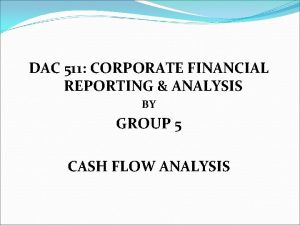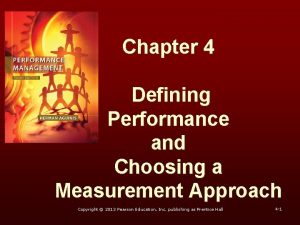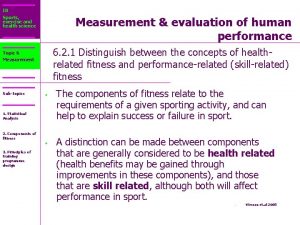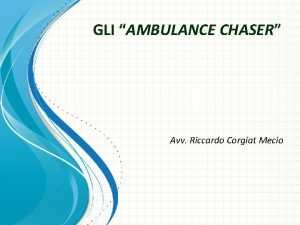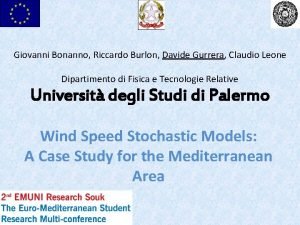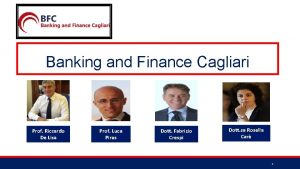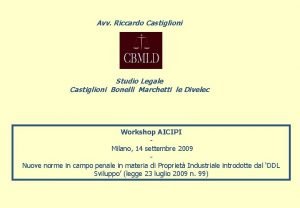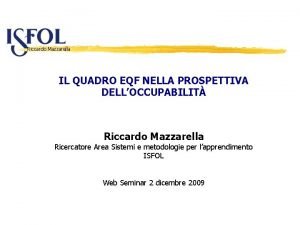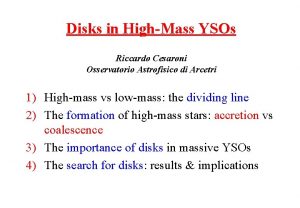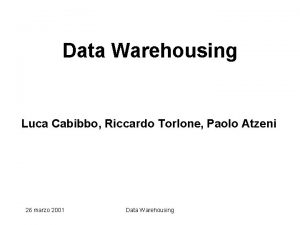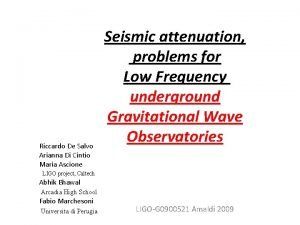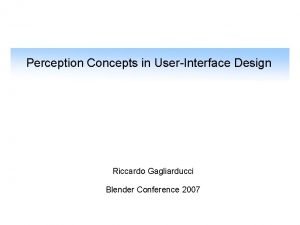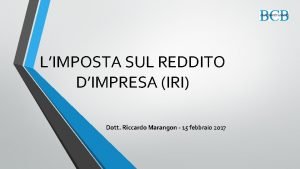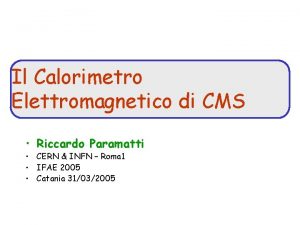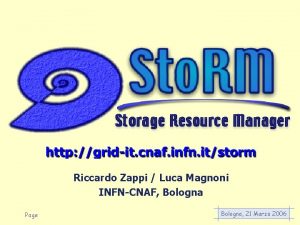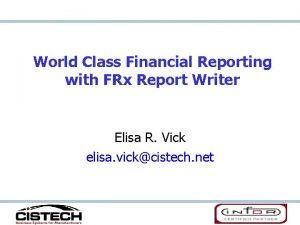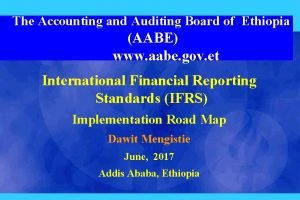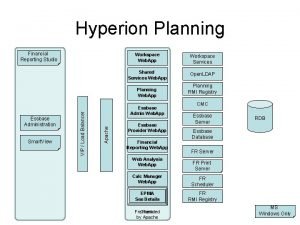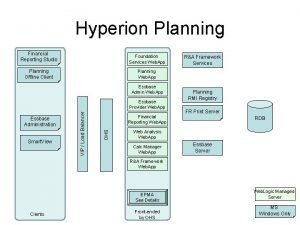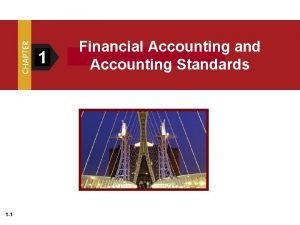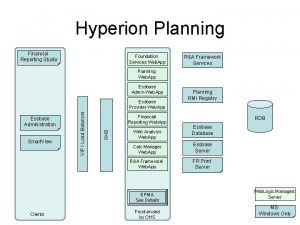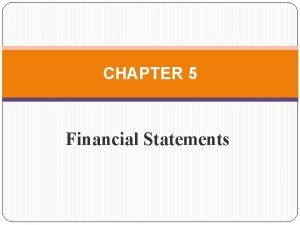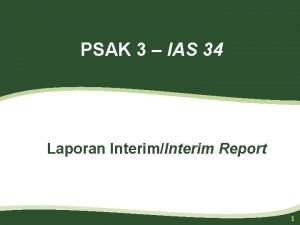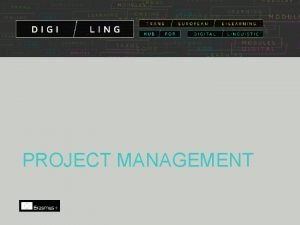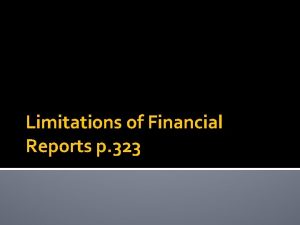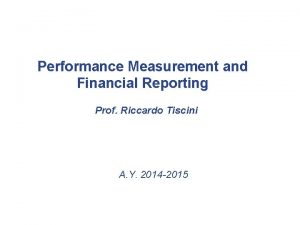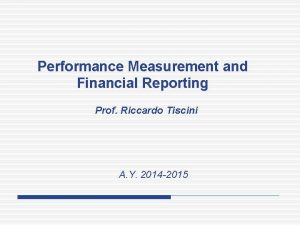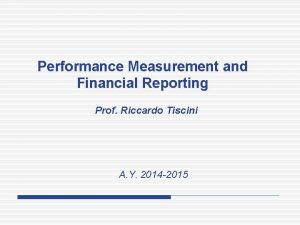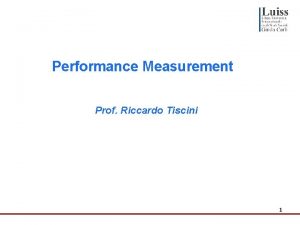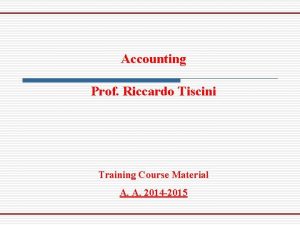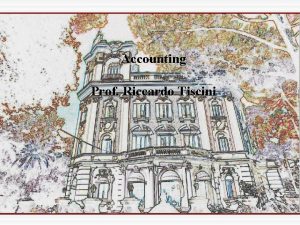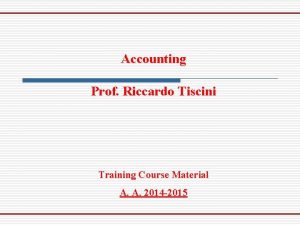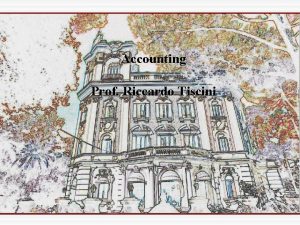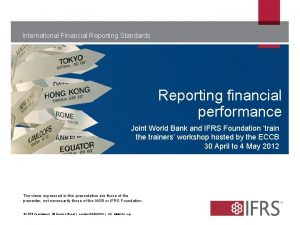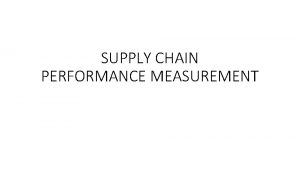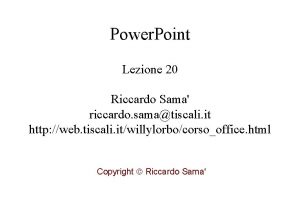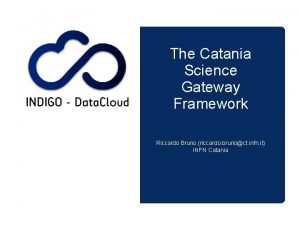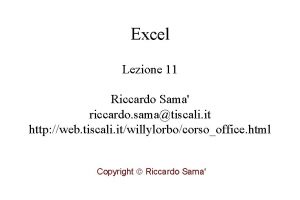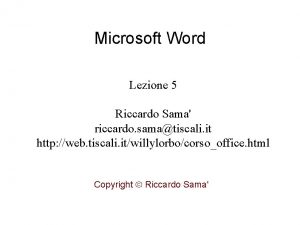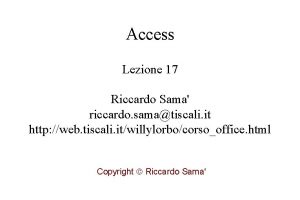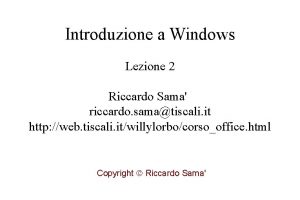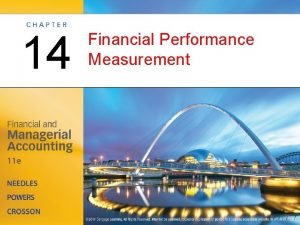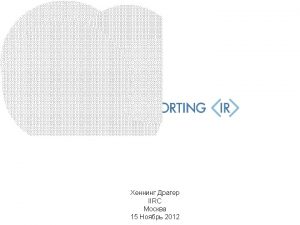Performance Measurement and Financial Reporting Prof Riccardo Tiscini


















































- Slides: 50

Performance Measurement and Financial Reporting Prof. Riccardo Tiscini A. Y. 2014 -2015

Syllabus Part III: Performance Measurement Theoretical foundations and main performance tools ü The concept of value. Performance measurement: financial and management accounting ü Financial analysis: general concepts and basics ü Financial indicators: ratio analysis o Profitability ratios o Liquidity ratios o Capital structure ratios o Cost volume analysis, BEP and operating leverage o MVA and EVA ü Case–studies and examples of practical performance measurement tools: value trees, KPIs and Balanced Scorecard

Part II Performance Measurement Theoretical foundations and main performance tools

Performance Measurement TOPICS OF PERFORMANCE MEASUREMENT FIRM As a whole Single parts of the firms Financial Accounting Management Accounting + NON FINANCIAL PERFORMANCE MEASURES

Financial Analysis. General concepts FINANCIAL STATEMENT OBJECTIVES 1. to fairly present the economic and financial position of a company to actual and potential stakeholders. 2. to understand the numbers, getting behind the figures, and use the understanding to better manage a business. FINANCIAL STATEMENT ANALYSIS Is the art of analyzing and interpreting financial statements. Thus, one may develop various analytical measures to portraits meaningful relationship and extract information from raw financial data.

Overview of company performance analysis 1. Understand Financial Statements Identiify Industry Economic Characteristics 3. Identify Company Strategy Analyze Profitability and Risk 5. 2. Value the Firm 4.

The concept of Value FIRM PURPOSE MAXIMISE SHAREHOLDERS VALUE Maximise future “results” + Control risk

The concept of Value SHAREHOLDER THEORY STAKEHOLDER VALUE THEORY “The social responsibility of business is to increase its profits” the purpose of the firm is “to serve as a vehicle for coordinating stakeholders interests” Friedman 1962 Evan and Freeman, 1988

The concept of Value Shareholder Value perspective Emphasize profitability over responsibility and see the organization primarily as instrument of its owners. Success can be measured by: • Share price • Dividends • Economic profits Stakeholder Value perspective Emphasize responsibility over profitability and see the organization primarily as a coalition to serve all parties involved. Success can be measured by: • Stakeholders satisfaction • See stakeholders management both as an end a means

Financial Statement FINANCIAL STATEMENT Prepared in accordance with Generally Accepted Accounting Principles / International Financial Reporting Standards They provide the basic information to monitor performance in terms of: • profitability: ability to sell products and generate profit • solidity: ability to pay long-term and short-term debts • liquidity: ability to pay debts and collect credits

Reformulated BS and IS – Financial method LIABILITIES ASSETS FIXED (NON CURRENT) ASSETS CURRENT ASSETS o tangible o intangible o financial o inventory o trade receivables o liquidity o prepaid expenses EQUITY o Shareholders’ Equity NON CURRENT LIABILITIES q Long-term Financial Debt o Long-term Trade payables CURRENT LIABILITIES q Short-term Financial Debt o Short-term Trade payables

Reformulated BS and IS – Operating method LIABILITIES ASSETS OPERATING ASSETS NON OPERATING ASSETS EQUITY o Shareholders’ Equity FINANCIAL DEBTS q Long-term Financial Debt o Short-term Financial Debt TRADE DEBTS q Long-term Trade payables q. Short-term Trade payables o fixed (non current) o current

Reformulated BS and IS – Operating method ASSETS LIABILITIES EQUITY (E) NET OPERATING INVESTED CAPITAL (NOIC) Fixed Assets + Inventory + Trade receivables - Trade payables NET FINANCIAL POSITION (NFP) Shareholders Equity Financial Debts -Liquidity (& Financial Current Assets) - Financial Fixed Assets

BS and IS Structure for Profitability Analysis SOURCES INVESTMENTS NET OPERATING INVESTED CAPITAL (NOIC) EQUITY (E) NET FINANCIAL POSITION (NFP) INCOME STATEMENT SALES (S) – OPERATING MONETARY COSTS = EBITDA -DEPRECIATION & AMORTIZATION -= EBIT - NET FINANCIAL EXPENSES/(REVENUERS) = EARNINGS BEFORE TAX (EBT) - INCOME TAX (T) = NET INCOME (NI)

BS and IS Structure for Profitability Analysis Deeper in the INCOME STATEMENT for Profitability Analysis: Sales - Variable Costs (raw mat. & oth. ) = CONTRIBUTION MARGIN - Fixed Services & Employee costs = EBITDA - Depreciation & Amortization = EBIT - Net interests expense (revenue) = EBT - Income Taxes = NET PROFIT (LOSS)

Financial Statement Analysis FINANCIAL ANALYSIS MAKE A JUDGEMENT PREDICT MAKE DECISIONS REMEMBER THAT NO SINGLE RATIO CAN TELL THE WHOLE PICTURE OF THE COMPANY’S PERFORMANCE

Using Ratio to make decisions Ratios can be classified as follows: Measuring ability to: PAY CURRENT LIABILITIES PAY LONG TERM DEBT SELL INVENTORY COLLECT RECEIVABLES Measuring profitability Analyzing stock as an investment

Financial Analysis RATIO ANALYSIS The analysis of the business by ratios It permits to predict the future development of the business on the basis of the historical performance study It’s largely used from everyone needs to analyse the financial results of transaction as a means of arriving at a measure of the firm’s success and financial performance.

Ratios Analysis LIQUIDITY RATIOS Ratios designed to measure the ability of the firm to meet its short term liabilities as they come due. The most common ratios are: current ratio; quick ratio. Ratios designed to measure the earning PROFITABILITY power of the firm. RATIOS The most common rations are: return on sales (ROS); return on invested capital (ROIC)* and return on equity (ROE) * In US analysts use ROA (return on assets)

Ratios Analysis WORKING CAPITAL (EFFICIENCY) RATIOS CAPITAL STRUCTURE (LEVERAGE) RATIOS Ratios designed to measure the relation between annual sales and investments in various classes of asset accounts. The most common ratios are: average stock period; average credit period; average debt period. The term leverage refers to the extend to which a firm employs debt capital to finance its operations. The main ratios in this category are: debt ratio; debt-asset ratio; debt-equity ratio; time interest earned ratio.

Ratios Analysis LIQUIDITY RATIOS They refer to the firm’s ability to meet short term obligations CURRENT RATIO QUICK RATIO CASH FLOW LIQUIDITY RATIO It measures the balance between current assets ( cash, account receivables, inventories) and liabilities It measures the balance between quick assets ( assets quickly converted to cash) and liabilities It tries to overcome some limitations of the previous ratios

Ratios Analysis PROFITABILITY FACTORS The Income Statement shows the final operating result (profit/loss for the period). Net profit shall be distributed to shareholders, who will then decide if this is satisfactory compared with costs. PROFITABILITY The common used measures of profitability are: ØReturn on equity (ROE) ØReturn on investments (ROIC) ØReturn on sales (ROS)

Financial Analysis RATIO ANALYSIS The analysis of the business by ratios ² Liquidity ratios ² Profitability ratios ² Working capital ratios ² Capital structure ratios

Profitability Ratios PERFORMANCE ANALYSIS PROFITABILITY of the capital invested by shareholders ROE NET PROFIT/EQUITY

Profitability Ratios FAIR ROE To establish if distributed profits are satisfactory or not, it is necessary to evaluate risk: FREE RISK INVESTMENTS RETURN & RISK PREMIUM Fair ROE = i (risk free) + Risk Premium i = risk-free return on investment R = extra charge related to entrepreneur’s risk

Financial Performance Analysis RETURN ON EQUITY Operating Profit ROIC + Financial Position

BS and IS Structure for Profitability Analysis Deeper in the INCOME STATEMENT for Profitability Analysis: Sales - Variable Costs (raw mat. & oth. ) = CONTRIBUTION MARGIN - Fixed Services & Employee costs = EBITDA - Depreciation & Amortization = EBIT - Net interests expense (revenue) = EBT - Income Taxes = NET PROFIT (LOSS)

ROIC (return on invested capital) = Ebit Net operating assets This ratio investigates the efficient usage of the capital invested in the business

ROIC RETURN ON INVESTED CAPITAL EBIT/NOIC ROS X CAPITAL TURNOVER EBIT/SALES X SALES/NOIC

Performance Analysis ROIC Key Factors Cost Volume Profit Analysis Operating income (EBIT) influenced by changes in production and sales Fixed assets Turnover Working capital cycle Analysis of revenues by fixed assets Average stock period + Average credit period Average debt period

Fixed Asset Turnover The Fixed Asset Turnover is the ratio of Sales to the value of Fixed assets. It indicates how well the business is using its fixed assets to generate sales. Fixed Asset Turnover SALES = FIXED OPERATING ASSETS The higher the ratio, the better, because a high ratio indicates the business has less money tied up in fixed assets for each unit of currency of sales.

Working Capital Ratios The Working Capital Cycle corresponds to the average time elapsed between cash payments to purchase production factors and cash takings generated by the sales of goods or services. Average stock period + Average credit period Average debt period DURATION OF THE = WORKING CAPITAL CYCLE This index is useful to assess liquidity problems due to mismatches between cash inflow and outflow.

Financial leverage Performance Analysis ROE Influenced by: = ü Operative leverage ROS = CAPITAL TURN OVER = ROIC Influenced by: ü Sales FIXED CAPITAL üOperating investments NET WORKING CAPITAL

Financial Leverage The degree to which an investor/business is utilizing borrowed money ROE(before taxes) = ROIC + (ROIC – i) * Q DEBT EQUITY RATIO = Q = FINANCIAL DEBTS EQUITY ROE(before taxes) = ROIC + (ROIC – i) * Fin. Debts/E i < ROIC I > ROIC positive financial leverage negative financial leverage

Financial Leverage ROE(before taxes) = ROIC + (ROIC – i) * Q HP 1 1. 000 150 - NOIC EQUITY FIN DEBTS i EBIT Taxes HP 2 2. 000 10% 300 - HP 2 3. 000 1. 000 2. 000 10% 450 - ROIC ? ROIC 15% 15% ROE ? ROE 15% 20% 25%

Capital Structure Ratios MEASURING ABILITY TO PAY LONG TERM DEBT RATIO + INTEREST-COVERAGE RATIO DEBT RATIO Fixed assets EQUITY Total liabilities Total assets Current assets Loans Liability It SHOWS THE PROPORTION OF ASSETS FINANCED WITH DEBT The higher the debt ratio, the higher the company’s financial risk

Capital Structure Ratios The debt ratio says nothing about the ability to pay interest expense. . . INTEREST-COVERAGE RATIO EBIT Interest expenses It measures the number of times operating income can cover (pay) interest expense A high interest-coverage ratio indicates ease in paying interest expense; a low ratio suggests difficulty

Performance analysis through ratios Downside of these ratios • • Sensitive to choice of accounting method Accumulation of monetary values from different periods Backward looking Fail to consider risk. NEED FOR OTHER FINANCIALLY BASED BUSINESS PERFORMANCE MEASUREMENTS

Economic Value Added (EVA) A SIMPLE DEFINITION OF EVA is a measure of economic profit. Stockholders need to know how successful the company is at creation new wealth. EVA measures in real terms the increase in wealth, defined as total equity, including both creditors’ and stockholders’ equity. WHY USING EVA TO MEASURE PERFORMANCE It is the financial performance measure that comes closer than any other to capturing the true economic profit of an enterprise.

Economic Value Added (EVA) IT QUANTIFIES THE ABNORMAL RETURNS ON INVESTMENTS AFTER… Operating costs Taxes Cost of capital

Economic Value Added (EVA) EVAt = NOPAT - (Invested capital*WACC) If NOPAT, invested capital and WACC are known, EVA can be calculated for any entity including: divisions, departments, product lines, geographic business segments. EVA is a flow, because it is a measure of profit.

Economic Value Added (EVA) EVA IS CALCULATED AS FOLLOWS: Net sales - Operating expenses = Operating profit (EBIT) - Taxes = Net Operating profit after taxes (NOPAT) - Capital charges (invested capital x cost of capital) = EVA

Economic Value Added (EVA) Weighted average cost of capital - WACC= Kd * (1 -t) * D/V + Ke * E/V Kd = cost of debt (included taxes) t = tax rate D = financial debts V = Firm value ( D+ E) Ke = cost of equity E = equity

Economic Value Added (EVA) COST OF DEBT: interest paid divided by the amount borrowed or Kd = Rf + spread Rf = return on a risk free investment Spread = according with the credit standing COST OF EQUITY: rate of return shareholders require on equity capital Ke determined with the CAPM MRP Ke = Rf + β * (E(Rm)- Rf) Rf = return on a risk free investment β = specific firm risk E(Rm) = expected return on the market MRP = market risk premium

Economic Value Added: NOPAT – NOIC*wacc ASSETS Fixed Oper. Assets Current Oper. Assets Cash and Cash Equivalents TOTAL Balance Sheet EQUITY + LIABILITIES 48. 000 Sh. Equity and Reserves 38. 900 Financial Debts 2. 400 Short term Financial Debts Trade Debts 89. 300 TOTALl 30. 000 49. 500 1. 100 8. 700 89. 300 Income Statement Revenues Expenses Depreciation Interests Expenses 14. 550 7. 650 3. 800 2. 623 Other information Risk Free Rate Beta Interest Rate Market risk premium Tax rate 1, 2% 1, 20 5, 18% 5, 8% 30, 0%

Economic Value Added: NOPAT – NOIC*wacc Balance Sheet Fixed Oper. Assets Current Oper. Assets Trade Debts NOIC total Sh. Equity and Reserves 38. 900 Financial Debts Short term Financial -8. 700 Debts Cash and Cash Equivalents 48. 000 78. 200 NFP Income Statement Revenues 78. 200 total Expenses EBITDA Depreciation EBIT Interests Expenses EBT Taxes NET INCOME 14. 550 7. 650 6. 900 3. 800 3. 100 2. 623 477 143 334 30. 000 49. 500 1. 100 -2. 400 48. 200 78. 200

Economic Value Added: NOPAT – NOIC*wacc Main ratios and EVA ROE pre tax ROE ROIC ROS CT 1, 59% 1, 11% 3, 96% 21, 31% 18, 61% CURRENT RATIO QUICK RATIO 421, 43% INT COV RATIO INT RATE (KD) NOPAT D E D+E D/D+E E/D+E KE 118, 19% 5, 18% 2. 170 50. 600 30. 000 80. 600 63% 37% 8% WACC=KE*E/(D+E)+KD*(1 -t)*D/(D*E) WACC EVA 5, 3% -1. 987

Economic Value Added (EVA) EVA adjustments: If generally accepted accounting principles distort the measures of invested capital and operating profit, users can make adjustments necessary to improve the precision of EVA as a measure of value creation. For example: adjustments may be required in the case R&D expenses are written off the balance sheet while they should be considered “investments”. In this case an adjustment is made by adding back this costs to the invested capital and to the NOPAT.

Economic Value Added (EVA) Many companies seem to be profitable but they are not… “Until a business returns a profit that is greater than its cost of capital, it operates a loss. ( Peter Druker, Harvard Business Review article) It helps manager to: v. MAXIMIZE THE WEALTH OF SHAREHOLDERS Identify the minimal acceptable compensation for investing in a risky enterprise. v. INCREASE THE MARKET VALUE OF THE COMPANY Increase in EVA will bring an increase in the market value of the company

Economic Value Added (EVA) ADVANTAGES OF EVA is conceptually simple EVA makes a manager care about assets as well as income EVA gives a better focus on how a company is performing EVA covers the full range of managerial decisions (strategic planning, allocating capital, pricing acquisitions, setting annual goals, etc. ) EVA can be used to quantify bonuses and incentives
 Ias 17 examples
Ias 17 examples Riccardo tiscini
Riccardo tiscini Ias 2
Ias 2 Progress and performance measurement and evaluation
Progress and performance measurement and evaluation Progress and performance measurement and evaluation
Progress and performance measurement and evaluation Direct vs indirect cash flow
Direct vs indirect cash flow What are the approaches to measuring performance
What are the approaches to measuring performance Approaches to measuring performance
Approaches to measuring performance Measurement and evaluation in human performance 5e download
Measurement and evaluation in human performance 5e download How to measure standing vertical jump
How to measure standing vertical jump Riccardo corgiat mecio
Riccardo corgiat mecio Leone class
Leone class Riccardo de lisa
Riccardo de lisa Riccardo castiglioni
Riccardo castiglioni Riccardo benussi
Riccardo benussi Riccardo faccini
Riccardo faccini Riccardo mazzarella
Riccardo mazzarella Anna rita simoni psichiatra
Anna rita simoni psichiatra Mass8mo
Mass8mo Luca cabibbo
Luca cabibbo Riccardo ascione
Riccardo ascione Riccardo puglisi
Riccardo puglisi Riccardo gagliarducci
Riccardo gagliarducci Riccardo cioffi
Riccardo cioffi Riccardo dominici
Riccardo dominici Riccardo desalvo
Riccardo desalvo Riccardo callegari
Riccardo callegari Riccardo marangon
Riccardo marangon Riccardo paramatti
Riccardo paramatti Riccardo magnoni
Riccardo magnoni Fernando pavarotti
Fernando pavarotti Riccardo puglisi moglie
Riccardo puglisi moglie Riccardo polastro
Riccardo polastro Riccardo asero
Riccardo asero Excludeproc.a
Excludeproc.a Riccardo sartori psicologo
Riccardo sartori psicologo Frx designer
Frx designer Accounting and audit board of ethiopia
Accounting and audit board of ethiopia Statement of financial purpose
Statement of financial purpose Essbase financial reporting studio
Essbase financial reporting studio Financial reporting studio
Financial reporting studio Intermediate accounting chapter 2
Intermediate accounting chapter 2 Financial accounting standards
Financial accounting standards What is financial reporting studio?
What is financial reporting studio? Fge financial management
Fge financial management Cbd financial reporting framework
Cbd financial reporting framework Ias 34 interim financial reporting
Ias 34 interim financial reporting Project management financial reporting
Project management financial reporting Limitations of annual reports
Limitations of annual reports Chapter 2 conceptual framework
Chapter 2 conceptual framework International financial reporting standards 9
International financial reporting standards 9


